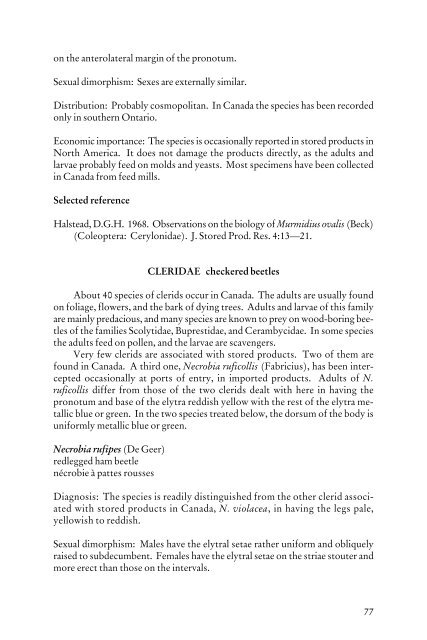Beetles Identification Guide
Beetles Identification Guide
Beetles Identification Guide
Create successful ePaper yourself
Turn your PDF publications into a flip-book with our unique Google optimized e-Paper software.
on the anterolateral margin of the pronotum.<br />
Sexual dimorphism: Sexes are externally similar.<br />
Distribution: Probably cosmopolitan. In Canada the species has been recorded<br />
only in southern Ontario.<br />
Economic importance: The species is occasionally reported in stored products in<br />
North America. It does not damage the products directly, as the adults and<br />
larvae probably feed on molds and yeasts. Most specimens have been collected<br />
in Canada from feed mills.<br />
Selected reference<br />
Halstead, D.G.H. 1968. Observations on the biology of Murmidius ovalis (Beck)<br />
(Coleoptera: Cerylonidae). J. Stored Prod. Res. 4:13—21.<br />
CLERIDAE checkered beetles<br />
About 40 species of clerids occur in Canada. The adults are usually found<br />
on foliage, flowers, and the bark of dying trees. Adults and larvae of this family<br />
are mainly predacious, and many species are known to prey on wood-boring beetles<br />
of the families Scolytidae, Buprestidae, and Cerambycidae. In some species<br />
the adults feed on pollen, and the larvae are scavengers.<br />
Very few clerids are associated with stored products. Two of them are<br />
found in Canada. A third one, Necrobia ruficollis (Fabricius), has been intercepted<br />
occasionally at ports of entry, in imported products. Adults of N.<br />
ruficollis differ from those of the two clerids dealt with here in having the<br />
pronotum and base of the elytra reddish yellow with the rest of the elytra metallic<br />
blue or green. In the two species treated below, the dorsum of the body is<br />
uniformly metallic blue or green.<br />
Necrobia rufipes (De Geer)<br />
redlegged ham beetle<br />
nécrobie à pattes rousses<br />
Diagnosis: The species is readily distinguished from the other clerid associated<br />
with stored products in Canada, N. violacea, in having the legs pale,<br />
yellowish to reddish.<br />
Sexual dimorphism: Males have the elytral setae rather uniform and obliquely<br />
raised to subdecumbent. Females have the elytral setae on the striae stouter and<br />
more erect than those on the intervals.<br />
77
















